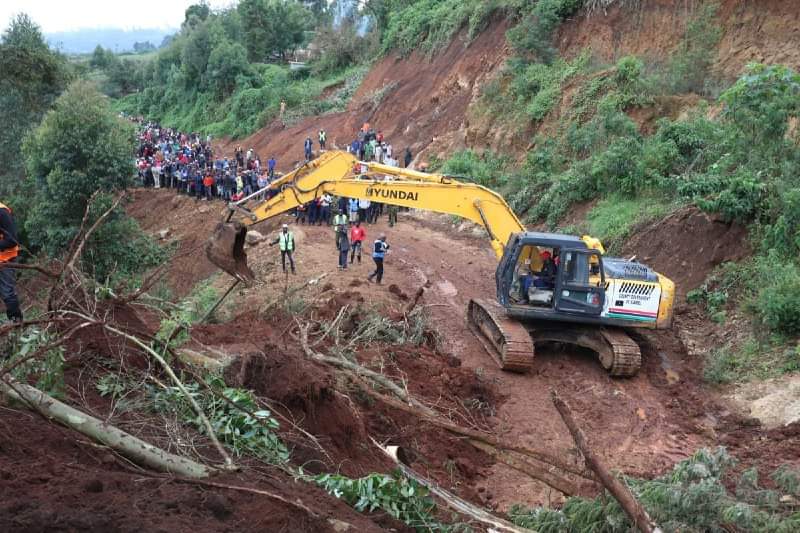A devastating landslide struck the Kimende escarpment in Kiambu county, Kenya, on Tuesday, May 14. The Kenya Red Cross swiftly responded, dispatching rescue teams to the scene amid fears that numerous individuals were trapped beneath the rubble. Eyewitnesses reported a grim scene, with several casualties, including passersby, succumbing to the force of the landslide. The incident highlights the unpredictable and often deadly consequences of natural disasters in vulnerable regions like the Kimende escarpment.
Landslides are geological phenomena characterized by the movement of a mass of rock, earth, or debris down a slope. They can be triggered by various factors, including heavy rainfall, earthquakes, volcanic activity, or human activities such as deforestation or construction. In the case of the Kimende escarpment, the exact cause of the landslide is yet to be determined, but the region’s steep terrain and susceptibility to erosion likely played significant roles.
The aftermath of a landslide is often chaotic and dangerous. Structures are destroyed, roads are blocked, and individuals may be buried under tons of debris. Rescue efforts become urgent as teams race against time to locate survivors and provide medical assistance. The Kenya Red Cross, along with other emergency responders, worked tirelessly to navigate the treacherous terrain and reach affected areas, demonstrating the importance of preparedness and swift action in disaster response.
The impact of the landslide extends beyond the immediate loss of life and property. Communities are left traumatized, infrastructure is compromised, and livelihoods are disrupted. The Kimende escarpment, like many regions prone to landslides, is home to vulnerable populations who often lack the resources and infrastructure to cope with such disasters. Addressing the long-term effects of the landslide will require coordinated efforts from government agencies, NGOs, and local communities to rebuild and strengthen resilience against future events.
Preventing landslides requires a multifaceted approach that addresses both natural and human-induced factors. Sustainable land management practices, such as afforestation, slope stabilization, and watershed management, can help mitigate erosion and reduce the risk of landslides. Early warning systems and community preparedness initiatives are also crucial for minimizing casualties and damage during landslide events. Education and awareness campaigns play a vital role in informing residents about the dangers of living in landslide-prone areas and empowering them to take proactive measures to protect themselves and their communities.
The Kimende landslide serves as a sobering reminder of the fragility of human settlements in the face of natural hazards. Climate change is exacerbating the frequency and intensity of extreme weather events, increasing the likelihood of landslides in vulnerable regions. As the global community grapples with the impacts of climate change, efforts to strengthen disaster resilience and adapt to evolving risks become paramount.
In the aftermath of the Kimende landslide, there will undoubtedly be calls for accountability and action to prevent similar tragedies in the future. Government agencies must prioritize investments in infrastructure, emergency response capabilities, and land-use planning to mitigate the impacts of landslides and other natural disasters. International cooperation and support can also play a vital role in bolstering the resilience of communities in landslide-prone regions, ensuring that no one is left behind in the face of adversity.
Ultimately, the story of the Kimende landslide is one of resilience and solidarity in the face of tragedy. Despite the devastation, communities will come together to support one another, rebuild what was lost, and work towards a safer, more sustainable future. As we reflect on this disaster, let us also redouble our efforts to protect vulnerable populations, preserve our natural environment, and build a world where disasters no longer cause such immense suffering and loss.
The devastating landslide that struck the Kimende escarpment in Kiambu county, Kenya, on Tuesday, May 14, sent shockwaves through the region, leaving behind a trail of destruction and despair. As the dust settled and rescue efforts intensified, the true scale of the tragedy began to emerge, painting a grim picture of loss and devastation.
Landslides are geological events characterized by the sudden movement of a mass of earth, rock, or debris down a slope. They can occur for various reasons, including heavy rainfall, seismic activity, erosion, or human interference. In the case of the Kimende escarpment, the exact cause of the landslide is still under investigation, but the region’s steep terrain and susceptibility to erosion likely contributed to the disaster.
The aftermath of a landslide is chaotic and dangerous, with structures destroyed, roads blocked, and individuals trapped beneath tons of debris. Rescue efforts become a race against time as emergency responders work tirelessly to locate survivors and provide medical assistance. The Kenya Red Cross, alongside other agencies, mobilized quickly to reach the affected areas and provide much-needed aid to those impacted by the disaster.
Eyewitness accounts painted a harrowing picture of the landslide’s immediate aftermath. Several casualties, including passersby, were reported, highlighting the indiscriminate nature of natural disasters. The loss of life is always tragic, but when coupled with the destruction of homes, livelihoods, and infrastructure, the impact of such events becomes even more profound.
In addition to the immediate loss of life and property, landslides can have long-term effects on affected communities. Trauma, displacement, and economic hardship often follow in the wake of such disasters, further exacerbating the challenges faced by vulnerable populations. The Kimende escarpment, like many regions prone to landslides, is home to marginalized communities who lack the resources and infrastructure to cope with such emergencies.
Addressing the root causes of landslides requires a multi-pronged approach that combines natural resource management, infrastructure development, and community resilience-building initiatives. Sustainable land-use practices, such as afforestation, slope stabilization, and watershed management, can help mitigate erosion and reduce the risk of landslides. Early warning systems, coupled with community preparedness efforts, are essential for minimizing casualties and damage during landslide events.
Education and awareness campaigns also play a crucial role in empowering communities to understand the risks associated with living in landslide-prone areas and take proactive measures to protect themselves. By fostering a culture of preparedness and resilience, communities can better withstand the impacts of natural disasters and recover more quickly in their aftermath.
The Kimende landslide serves as a stark reminder of the urgent need for action to address the growing threat of landslides and other climate-related hazards. Climate change is exacerbating the frequency and intensity of extreme weather events, making vulnerable communities even more susceptible to disasters. As such, investments in disaster risk reduction, climate adaptation, and sustainable development are essential for building more resilient societies.
In the wake of the Kimende landslide, there will undoubtedly be calls for accountability and action to prevent similar tragedies in the future. Government agencies must prioritize investments in infrastructure, emergency response capabilities, and land-use planning to mitigate the impacts of landslides and other natural disasters. International cooperation and support can also play a vital role in bolstering the resilience of communities in landslide-prone regions, ensuring that no one is left behind in the face of adversity.
Ultimately, the story of the Kimende landslide is one of resilience and solidarity in the face of tragedy. Despite the devastation, communities will come together to support one another, rebuild what was lost, and work towards a safer, more sustainable future. As we reflect on this disaster, let us also redouble our efforts to protect vulnerable populations, preserve our natural environment, and build a world where disasters no longer cause such immense suffering and loss.

